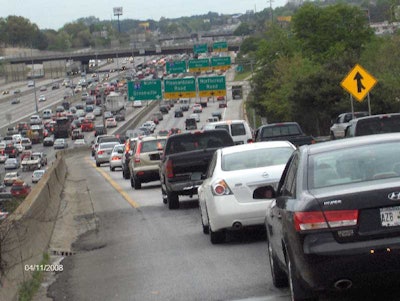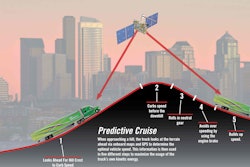
Earlier this month, at the CCJ Fall Symposium in Scottsdale, Ariz., (click here for full coverage) the conversation at the dinner table one evening turned to autonomous trucks and the impact they will soon have on this industry and society at large. And as the conversation progressed, an interesting point came up that is often overlooked when truckers talk about autonomous vehicles: The fact that autonomous technology could end, or, more likely in my view, vastly improve heavy urban traffic congestion.
I flew into Dallas, Texas, in mid-November for a Peterbilt test drive. Peterbilt’s headquarters is in the Denton, Texas, suburb, about 30 miles outside of Dallas.
The Dallas-Fort Worth urban area is one of the largest in the U.S., home to about 7 million people. And as I’d landed just ahead of rush hour, it looked to me that at least half of those people were sitting in cars inching along the spaghetti snarl of interstates that surround DFW airport.
 Freightliner’s Inspiration, a Level 3 autonomous vehicle. Freightliner’s truck is legally licensed to operate in Nevada.
Freightliner’s Inspiration, a Level 3 autonomous vehicle. Freightliner’s truck is legally licensed to operate in Nevada.I loathe traffic jams: Shakespeare himself would have to reanimate from the grave, move into a seedy London apartment and start inventing wholly new words for the English language before I could begin to tell you how much I hate sitting in traffic jams. I just don’t have the patience for them. To me, they are simply the biggest waste of time, energy and resources on the planet today.
It’s flat as a pancake around Dallas. So I could easily see 10 miles in any given direction. The sun was setting and all I could see was an endless sea of headlights and taillights glowing in the dusk.
I don’t know how much money you’d have to pay me to sit in traffic like that every day, but trust me, it would be a hefty amount.
Traffic congestion is a very complex issue, with many contributing factors. But one of the biggest in play is the human factor. Humans just don’t do well in heavy traffic like that. People (like me) are frustrated. Some of them aren’t sure which lane they need to get in. Others do know which exit they need, but it’s four clogged lanes over to the right. No one has any idea what the other cars and trucks around them intend to do. Essentially, we all have to wing it. It’s horribly inefficient and very quickly devolves into a modern-day accordion nightmare of sit, go, wait, brake, gas it and sit again.
But what happens in the near future when a certain percentage of the vehicles sitting around you in any given traffic jam are autonomous vehicles?
And what if those vehicles are communicating in real time with each other and talking to the road system as well? What does that technology do to end a problem that all of us face far too often?
Does introducing any level of artificial intelligence-generated efficiency to a snarled interstate immediately produce smoother traffic flow and reduced commute times? Or is human inefficiency so overwhelming that the autonomous vehicle effect is minimal? Or, given the fact that humans are really good at creating chaos, would we overwhelm the computers and make things even worse?
The answers I suspect lie in how many autonomous vehicles are in the mix. If 25 percent of the cars around you in a massive traffic jam are being autonomously controlled, maybe you see a few small increases in traffic flow. And maybe if half the cars are being driven by robotic systems, you start to see real improvements and a serious cut in your commute time. And then, when the majority of vehicles around you are talking and working together, you see traffic jams become a thing of the past.
Those are just guesses, of course. But I think that one day in the near future we’ll know the answer to those questions.
And here’s the larger point: When I talk about autonomous trucks today, the reactions are always loaded with angst. Drivers, for instance, focus on what they’re supposed to do — sit for hours behind a steering wheel while a truck drives itself down the road. (Assuming that they’re not wondering if the truck will simply not need a driver anymore and they’ll be looking for a job.)
Those are fair points. But when it comes to phasing this technology into our industry and society at large, we simply don’t know what we don’t know, meaning time will only tell how the automated vehicle revolution will unfold.
But there is much more at stake with autonomous vehicles than simply giving drivers a break every now and then. When you start thinking about the wider implications of autonomous vehicles, you start to understand the massive gains in efficiency and time that this technology could deliver in the very near future.
Drivers may sneer at the thought of surrendering control of the vehicle and simply sitting there watching the scenery pass by.
And I tend to agree. I like to drive, too. But soon there may be situations like that nightmare Dallas traffic jam where a smart driver will want to put the truck in autonomous mode, because doing so will save time, money and fuel.
We’re far from having the integrated infrastructure and number of autonomous vehicles we need to kill congestion. But the idea is a sound one and highlights how autonomous vehicle control could very soon be a powerful tool in a driver’s arsenal to help them make more money, reduce stress and ensure on-time deliveries and a quicker return home.









